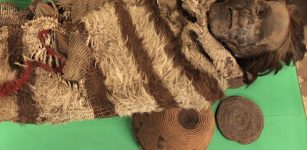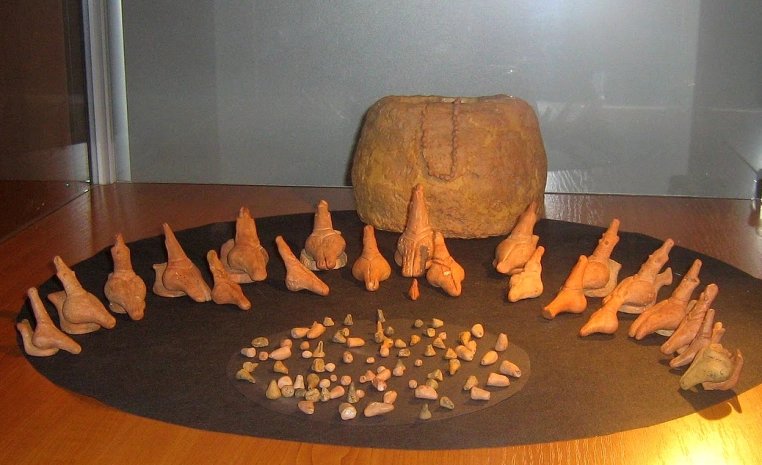Mysterious Cucuteni-Tyrpillian Culture Burned Their Settlements For Unknown Reasons
Ellen Lloyd - AncientPages.com - The mysterious Cucuteni-Trypillian culture lived in Eastern Europe thousands of years ago. They left behind a number of intriguing ancient artifacts, destroyed settlements, and sacred sanctuaries. It remains unclear why and how they vanished. It is also a mystery why they regularly burned their settlements.
These people lived in an area of around 35,000 square kilometers, incorporating parts of present-day Moldova, Romania, and Ukraine, between 5400 and 2700 BCE.
The discovery of the Cucuteni-Trypillian culture
The culture was initially named after the village of Cucuteni in Romania.
In 1884, Teodor T. Burada, after having seen ceramic fragments in the gravel used to maintain the road from Târgu Frumos to Iași, investigated the quarry in Cucuteni from where the material was mined, where he found fragments of pottery and terracotta figurines.
At the same time, in 1893, the first Ukrainian sites ascribed to the culture were discovered by Vicenty Khvoika, who found ancient ruins near the village of Trypillia in the Obukhiv District of central Ukraine's Kiev Oblast.
Prior to the discovery of Trypillia in the late 19th century – a time when great archeological discoveries were taking place in various parts of the world – it seemed that Eastern Europe had made no notable prehistoric contributions to the development of so-called civilization in the region. But all this changed in 1893 as archeologists started to explore the ruins of these ancient settlements and discovered that the Cucuteni-Trypillian culture had established cities to accommodate up to 15,000 inhabitants, being some of the largest settlements in Neolithic European history (7000 BCE-1700BCE)
The Cucuteni-Trypillian Deliberately Burned Their Settlements Regularly
In the middle era, the Cucuteni-Trypillian culture spread over a wide area from Eastern Transylvania in the west to the Dnieper River in the east. During this period, the population immigrated into and settled along the banks of the upper and middle regions of the Right Bank (or western side) of the Dnieper River in present-day Ukraine. The population grew considerably during this time, resulting in settlements being established on plateaus near major rivers and springs.
 Recreation of a Cucuteni-Trypillian house burning. Credit: Arheoinvest - Public Domain
Recreation of a Cucuteni-Trypillian house burning. Credit: Arheoinvest - Public Domain
Archaeologists noticed something strange while investigating the ruins left behind by the Cucuteni-Tyrpillian culture. These ancient people deliberately burned their settlements after some years.
The purpose of the periodic destruction of settlements, with each single-habitation site having a roughly 60 to 80-year lifetime, remains debated among scholars. Some of the settlements were reconstructed several times on top of earlier habitational levels, preserving the older buildings' shape and orientation. One particular location, the Poduri site (Romania), revealed thirteen habitation levels that were constructed on top of each other over many years.
Archaeological Treasures And Sacred Sanctuaries Of The Cucuteni-Trypillian Culture
Archeological treasures recovered from these sites include statuettes of both men and women, weapons and other items made of copper and other metals, intricately patterned earthenware, and clay building materials. The female statuettes have featureless faces, while the males have oval, elongated faces with prominent noses and deep-set eyes. Some of the statuettes are naked while others are clothed, with the styles of clothing changing over the years, and the females wore their hair in different styles.
During excavations, archaeologists found several sacred sanctuaries. Artifacts inside these sanctuaries were intentionally buried in the ground within the structure. These objects are clearly of a religious nature and have provided insights into some of the beliefs, and perhaps some of the rituals and structure, of the members of this society.
Many of these artifacts are clay figurines or statues. It is commonly assumed that many of these artifacts are fetishes or totems, which are believed to be imbued with powers that can help and protect the people who look after them.
The End Of The Cucuteni-Trypillian Culture Remains An Open Question
Why the Cucteni-Trypullian culture vanished remains unknown. Scholars have debated the end of the culture, and there are several theories.
According to archaeologist Marija Gimbutas, the Cucuteni-Trypillian culture ended violently in connection with the territorial expansion of the Kurgan culture. Proponents of the Kurgan Hypothesis hold that a violent clash took place during the Third Wave of Kurgan expansion between 3000-2800 B.C.permanently ending the Cucuteni-Trypillian culture.
J.P. Mallory, an Irish-American archaeologist, is not convinced the Cucteni-Trypullian culture met a violent end. Instead, he points out that archaeological evidence indicates what he termed "a dark age," during which the population sought refuge in every direction except the east. He cites evidence of the refugees having used caves, islands, and hilltops (abandoning in the process 600-700 settlements) to argue for the possibility of a gradual transformation rather than a violent onslaught bringing about cultural extinction.
Reconstruction of the Trypillian city Maydanets c 4000 B.C. The Cucuteni-Trypillian culture built large settlements. Credit: Wikipedia - CC BY-SA 4.0
Another theory regarding the end of the Cucuteni-Trypillian culture emerged based on a climatic change at the end of their culture's existence known as the Blytt-Sernander Sub-Boreal phase. Beginning around 3200 B.C, the earth's climate became colder and drier than it had ever been since the end of the last Ice Age, resulting in the worst drought in the history of Europe since the beginning of agriculture. Since the Cucuteni-Trypillian people consisted mostly of farmers, the culture would have collapsed under these climatic conditions.
Written by Ellen Lloyd – AncientPages.com
Copyright © AncientPages.com All rights reserved. This material may not be published, broadcast, rewritten or redistributed in whole or part without the express written permission of AncientPages.com
Expand for referencesMore From Ancient Pages
-
 Untold Story Of Mexico’s Ancient Giant Indians – Secret Knowledge Of The Aztecs Revealed – Part 1
Ancient Mysteries | Sep 21, 2019
Untold Story Of Mexico’s Ancient Giant Indians – Secret Knowledge Of The Aztecs Revealed – Part 1
Ancient Mysteries | Sep 21, 2019 -
 Previously Unknown Early Christian Church Unearthed In Ancient City Of Artaxata
Archaeology | Oct 18, 2024
Previously Unknown Early Christian Church Unearthed In Ancient City Of Artaxata
Archaeology | Oct 18, 2024 -
 Ancient Maya Lessons On Surviving Drought – Examined By Scientists
Archaeology | Jan 5, 2022
Ancient Maya Lessons On Surviving Drought – Examined By Scientists
Archaeology | Jan 5, 2022 -
 Bizarre Ancient Capuchin Crypt ‘Decorated’ With The Bones Of 4,000 Monks
Ancient Traditions And Customs | Nov 22, 2018
Bizarre Ancient Capuchin Crypt ‘Decorated’ With The Bones Of 4,000 Monks
Ancient Traditions And Customs | Nov 22, 2018 -
 Where Is One Of Colorado’s Most Mysterious Long-Lost Artifacts? Have New Clues Emerged?
Featured Stories | Aug 20, 2024
Where Is One Of Colorado’s Most Mysterious Long-Lost Artifacts? Have New Clues Emerged?
Featured Stories | Aug 20, 2024 -
 Controversial Discovery Of 5,7-Million-Year-Old Footprints On Crete Could Re-Write History Of Human Evolution
Archaeology | Sep 5, 2017
Controversial Discovery Of 5,7-Million-Year-Old Footprints On Crete Could Re-Write History Of Human Evolution
Archaeology | Sep 5, 2017 -
 Yehasuri – Little People Of South Carolina Living In The Woods – Native Americans’ Version Of Leprechauns
Featured Stories | Feb 26, 2019
Yehasuri – Little People Of South Carolina Living In The Woods – Native Americans’ Version Of Leprechauns
Featured Stories | Feb 26, 2019 -
 Traces Of Advanced Beings Who Walked Earth Millions Of Years Ago: Controversial Ancient History Examined
Ancient Mysteries | Jun 20, 2018
Traces Of Advanced Beings Who Walked Earth Millions Of Years Ago: Controversial Ancient History Examined
Ancient Mysteries | Jun 20, 2018 -
 Prehistoric Anomaly On The Tennessee-North Carolina Border Baffles Scientists
Featured Stories | Jul 30, 2024
Prehistoric Anomaly On The Tennessee-North Carolina Border Baffles Scientists
Featured Stories | Jul 30, 2024 -
 3,500-Year-Old Tomb Discovered In Luxor – Who Is The Royal Buried Inside?
Archaeology | Jan 16, 2023
3,500-Year-Old Tomb Discovered In Luxor – Who Is The Royal Buried Inside?
Archaeology | Jan 16, 2023 -
 Hayk – Legendary Patriarch And Founder Of Armenia Who Defeated King Bel Of Babylon
Featured Stories | Feb 10, 2022
Hayk – Legendary Patriarch And Founder Of Armenia Who Defeated King Bel Of Babylon
Featured Stories | Feb 10, 2022 -
 Mystery Of Great Wall Of California: An Ancient Unsolved Enigma
Featured Stories | Oct 28, 2015
Mystery Of Great Wall Of California: An Ancient Unsolved Enigma
Featured Stories | Oct 28, 2015 -
 History Mystery: Gold Tool Found In Jerusalem Cemetery Baffles
Archaeology | Dec 25, 2015
History Mystery: Gold Tool Found In Jerusalem Cemetery Baffles
Archaeology | Dec 25, 2015 -
 Neolithic Boats At La Marmotta Reveal People Used Advanced Nautical Technology 7,000 Years Ago
Archaeology | Mar 22, 2024
Neolithic Boats At La Marmotta Reveal People Used Advanced Nautical Technology 7,000 Years Ago
Archaeology | Mar 22, 2024 -
 Ancient City Of Ipiutak Was Built By A Fair-Haired Race With Blue Eyes And Not Us – The Inuit Say
Featured Stories | Apr 23, 2019
Ancient City Of Ipiutak Was Built By A Fair-Haired Race With Blue Eyes And Not Us – The Inuit Say
Featured Stories | Apr 23, 2019 -
 Remarkable Underground City Of Nushabad: A Masterpiece Of Ancient Architecture
Ancient Technology | Nov 17, 2015
Remarkable Underground City Of Nushabad: A Masterpiece Of Ancient Architecture
Ancient Technology | Nov 17, 2015 -
 DNA Taken From Cement On Hairs Belonging To Ancient Mummies Shed Light On South American Ancestry
Archaeology | Dec 29, 2021
DNA Taken From Cement On Hairs Belonging To Ancient Mummies Shed Light On South American Ancestry
Archaeology | Dec 29, 2021 -
 Ancient Fossil Found In Sahara Suggests Loch Ness Monster Could Be Real
Archaeology | Jul 27, 2022
Ancient Fossil Found In Sahara Suggests Loch Ness Monster Could Be Real
Archaeology | Jul 27, 2022 -
 Fenrir: Oldest Of Three Monstrous Children Of God Loki In Norse Mythology
Featured Stories | Mar 28, 2018
Fenrir: Oldest Of Three Monstrous Children Of God Loki In Norse Mythology
Featured Stories | Mar 28, 2018 -
 Superhighways Traveled By The First Australians Reveal A 10,000-Year Journey Through The Continent – New Study
Archaeology | Feb 3, 2023
Superhighways Traveled By The First Australians Reveal A 10,000-Year Journey Through The Continent – New Study
Archaeology | Feb 3, 2023




